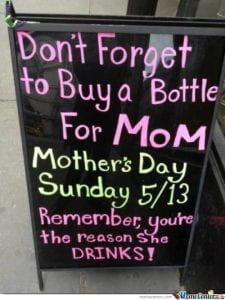New research has shown that men and women experience drinking alcohol differently. These findings are a reason to pause and reflect on our drinking habits and norms and to ask ourselves why we drink, how much do we drink and when are we drinking the most. Additionally, advertising firms are quick to exploit our weaknesses in pursuit of profit. There is a surprising parallel between the sharp increase in women’s alcohol use (especially high-risk drinking) and the rise of Skinny Girl brand and Mommy’s Night Out wines and others that are specifically targeting the female drinker [1]. While the occasional drink imbibed responsibly in a social environment is not the target of this blog, it might surprise you to learn of the following biological differences of alcohol use among men and women that could be contributing to potentially harmful drinking-related outcomes.
- Women and men drink for different reasons.
Depression and other poor mental health outcomes have long been linked to alcohol use and substance abuse[2]. New research suggests that a driving factor for women to consume alcohol is a negative reinforcement where women are trying to hide or mask an underlying stressor. There is a body of evidence that posits that adolescent girls are twice as more likely as their adolescent boy counterparts to experience depression. Adolescent girls who experience stress-related activities might be more likely to turn to alcohol and drugs in early adulthood to cope[3]. Other research has shown that the association between substance abuse and depression is more pronounced in adolescent girls than adolescent boys [4]. While the exact interaction between women’s mental health and alcohol use is still being explored, evidence suggests that women are more likely to drink if they experience some combination of depression, stress and or anxiety or sexual trauma or sexual abuse [5, 6]. These are examples of negative reinforcement, and they are the primary drivers motivating women to drink. While men, on average, are more likely to be motivated to drink associated with higher thrill-seeking behaviors, lower inhibitions, and other behaviors that can be categorized as positive reinforcements.
- Women and men react differently to alcohol consumption.
On average, men tend to have lower levels of reaction to alcohol consumption compared to women. Studies on women and men’s alcohol behavior suggestion that since men tend to exhibit low alcohol reactivity that they may consume more alcohol to feel its effects and gradually this behavior, if sustained can lead to a higher tolerance and possibly dependence [6]. Women appear to react much quicker to the effects of alcohol. Also, studies comparing the effects of drinking in women and men found that women display greater deficiencies in motor and cognitive skills compared to men when both the women and men had the same amount to drink. This same study also showed that as the participant’s continued to drink over several days that the men developed a tolerance and reacted less strongly to the alcohol whereas the women’s negative reaction and increased sensitivity to alcohol became even more pronounced [7].
- Women face higher alcohol-related health risks than men.
Women who consume more than one alcoholic beverage a day are at risk for numerous health issues compared to men whose drinking patterns exceed moderate levels. For example, when compared to men, women are more likely to have inflamed livers, have increased risk of heart disease, and have an increased risk of breast cancer. Additionally, while there are several differing opinions and advice on how much alcohol a woman should consume when pregnant, the ruling advice is for pregnant women to avoid alcohol entirely while pregnant or even if they suspect they are pregnant to protect the developing fetus. Some of the biological reasons that women experience more significant health risks than men are due to the fact that on average, women’s body weight is lower compared to men, pound for pound women’s bodies contain less water than men, so women’s blood alcohol level is affected quicker, and estrogen levels influence how women’s livers process alcohol differently than men [8].
In the US and many other countries around the world, it is the social and cultural norm to drink especially at certain functions or social events like weddings, sporting events, and festivals to name a few. While drinking is often deeply rooted in our norms, it never hurts to have health-related information to guide our decisions and occasionally serve as a barometer for when a fun activity turns into a hazard. Women should be aware of the additional risks that drinking poses for them not necessarily to abstain from alcohol together but to continue to drink responsibly if they so choose.
- Grant, B.F., et al., Prevalence of 12-Month Alcohol Use, High-Risk Drinking, and DSM-IV Alcohol Use Disorder in the United States, 2001-2002 to 2012-2013: Results From the National Epidemiologic Survey on Alcohol and Related ConditionsPrevalence of Alcohol Use, High-Risk Drinking, and DSM-IV Alcohol Use DisorderPrevalence of Alcohol Use, High-Risk Drinking, and DSM-IV Alcohol Use Disorder. JAMA Psychiatry, 2017. 74(9): p. 911-923.
- Ramsey, S.E., P.A. Engler, and M.D. Stein, Alcohol Use Among Depressed Patients: The Need for Assessment and Intervention. Professional psychology, research and practice, 2005. 36(2): p. 203-207.
- Nolen-Hoeksema, S., Gender Differences in Depression. Current Directions in Psychological Science, 2001. 10(5): p. 173-176.
- Hallfors, D.D., et al., Which Comes First in Adolescence—Sex and Drugs or Depression? American Journal of Preventive Medicine, 2005. 29(3): p. 163-170.
- Poulin, C., et al., Gender differences in the association between substance use and elevated depressive symptoms in a general adolescent population. Addiction, 2005. 100(4): p. 525-35.
- Champion, H.L., et al., Adolescent sexual victimization, use of alcohol and other substances, and other health risk behaviors. J Adolesc Health, 2004. 35(4): p. 321-8.
- Dougherty, D.M., J.M. Bjork, and R.H. Bennett, Effects of alcohol on rotary pursuit performance: A gender comparison. The Psychological Record, 1998. 48(3): p. 393-405.
- NIAA. Women. 2019; Available from: https://www.niaaa.nih.gov/alcohol-health/special-populations-co-occurring-disorders/women.

